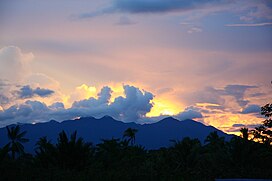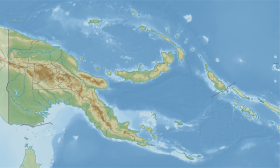Mount Bosavi
| Mount Bosavi | |
|---|---|
 Mount Bosavi in October 2008 | |
| Highest point | |
| Elevation | 2,507 m (8,225 ft)[1][2] |
| Prominence | 1,887 m (6,191 ft)[2] |
| Listing | Ultra, Ribu |
| Coordinates | 6°36′51″S 142°49′36″E / 6.61417°S 142.82667°E[2] |
| Geography | |
| Location | Southern Highlands, Papua New Guinea |
| Geology | |
| Mountain type | Volcano |
| Last eruption | 200,000 years ago[3] |
Mount Bosavi is a mountain in the Southern Highlands province, Papua New Guinea. It is the collapsed cone of an extinct volcano on the Great Papuan Plateau, part of the Kikori River basin.[4] The crater is approximately 4 km wide and 1 km deep;[3] it is home to a number of endemic species.
Part of the mountain is included in the Sulamesi Wildlife Management Area, established in 2006. It forms part of the proposed UNESCO World Heritage Site Kikori River Basin/Great Papuan Plateau.[5] The people living just north of the mountain refer to themselves as Bosavi kalu (people of Bosavi) and divide into four culturally identical but linguistically marked groups, the Kaluli, Ologo, Walulu, and Wisesi. Collectively they are often referred to as Bosavi kalu ("men of Bosavi").[4]
Fauna and flora
[edit]A 2009 expedition by an international team of scientists and a television crew from the BBC Natural History Unit filming Lost Land of the Volcano, a BBC wildlife documentary, discovered more than 40 previously undescribed species, including 16 frogs, at least 3 fish, several insects and spiders, a bat, and a giant rat, measuring 82 cm in length and weighing approximately 1.5 kg.[3][6] Mount Bosavi is also the type locality for Pseudohydromys pumehanae, a recently described species of moss-mouse.
See also
[edit]References
[edit]- Hammond World Travel Atlas. Union, N.J.: Hammond World Atlas Corporation. 2005. ISBN 0-8437-1982-6.
- Feld, Steven (1982). Sound and Sentiment: Birds, Weeping, Poetics, and Song in Kaluli Expression. Philadelphia: University of Pennsylvania Press.
- Footnotes
- ^ Hammond World Travel Atlas p. 243
- ^ a b c "Papua New Guinea; Ultra-Prominence page". peaklist.org. Retrieved 2014-02-15.
- ^ a b c Booth, Robert (7 September 2009). "Lost world of fanged frogs and giant rats discovered in Papua New Guinea". The Guardian. Retrieved 2014-02-15.
- ^ a b Feld, pp.3–4
- ^ "Kikori River Basin / Great Papuan Plateau". UNESCO World Heritage Centre. Retrieved 2007-02-22.
- ^ "Giant rat found in 'lost volcano'". BBC News. 6 September 2009. Retrieved 2014-02-15.
External links
[edit]- Satellite view from the European Space Agency
- WWF page of Libano and Sulamesi Wildlife Management Areas, including map
- WWF pictures from Mt. Bosavi and region
- Seacology Mt. Bosavi Rainforest Conservation Project Seacology
- "Mount Bosavi, Papua New Guinea" on Peakbagger
- "Bosavi". Global Volcanism Program. Smithsonian Institution. Retrieved 2021-06-25.

